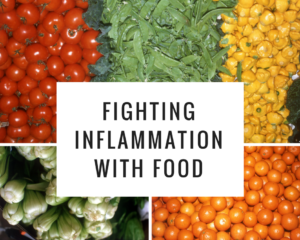28 Apr How to Fight Inflammation with Food
 Inflammation can be a big contributor to pain. It can cause damage in the body and can prevent daily activities. Our diets play a big role in helping our bodies fight inflammation and pain. Compounds called antioxidants, found in many common foods, can help reduce inflammation and damage-causing free radicals. Free Radicals are man-made or natural elements including chemicals your body produces by turning food into energy; environmental toxins, like tobacco, alcohol, and pollution; UV rays from the sun or tanning bed; and substances found in processed foods.
Inflammation can be a big contributor to pain. It can cause damage in the body and can prevent daily activities. Our diets play a big role in helping our bodies fight inflammation and pain. Compounds called antioxidants, found in many common foods, can help reduce inflammation and damage-causing free radicals. Free Radicals are man-made or natural elements including chemicals your body produces by turning food into energy; environmental toxins, like tobacco, alcohol, and pollution; UV rays from the sun or tanning bed; and substances found in processed foods.
In fact, diets high in processed foods are a big cause of inflammation. These foods are known as proinflammatory foods. Proinflammatory cytokines are used in cell signaling and promote systemic inflammation and can make diseases, like cardiovascular disease and diabetes, worse. In contrast to the inflammation-causing proinflammatory cytokines, anti-inflammatory cytokines, promote healing and reduce inflammation. Scientific research continues to show diets rich in antioxidants can help to reduce the number of free radicals in the body, thus, reducing inflammation and pain. Whereas, diets high in processed, fatty/greasy foods promote inflammation.
“When dealing with pain, diet can be your biggest ally or your worst enemy.”
Eating a VARIETY of fruits, vegetables and whole grain products can increase the number of antioxidant compounds and help your body to reduce inflammation and promote healing. Antioxidants are man-made or natural substances that may prevent or delay some types of cell damage. Examples of antioxidants can be found in many of the fruits and vegetables and include: beta-carotene, lutein, lycopene, selenium, Vitamins A, C & E.
Our bodies have a natural inflammation fighting force. We can help to strengthen that by choosing a variety of these anti-inflammatory foods to help decrease pain:
- Vitamin A is in milk, butter, eggs and liver.
- Vitamin C is in most fruits and vegetables: berries, oranges, kiwis, cantaloupes, papayas, broccoli, bell peppers, tomatoes, cauliflower, Brussels sprouts and kale.
- Vitamin E is in some nuts and seeds (almonds, sunflower seeds, hazelnuts and peanuts), green leafy vegetables (spinach/Kale), also found in oils (soybean, corn and canola oils).
- Beta-Carotene is in brightly colored vegetables and fruits (peaches, apricots, papayas, mangoes, cantaloupes, carrots, peas, broccoli, squash, sweet potatoes, beet greens, spinach and kale).
- Lycopene is in pink and red fruits and vegetables (pink grapefruits, watermelon, apricots and tomatoes)
- Lutein is in green leafy vegetables (spinach, collards, kale, broccoli, corn, peas, papayas and oranges)
- Selenium is found in pasta, bread and grains (including corn, wheat and rice). It is also found in animal products (beef, fish, turkey, chicken). There are also amounts found in nuts, legumes, eggs, and cheese.
Warning: Too much antioxidants (from supplementation or diet) can be harmful. Talk with your doctor before changing your diet or taking supplements.
*Sources: NIH: National Center for Complementary and Integrative Health. *Academy of Nutrition and Dietetics *Medline Plus
 For more information on The Pain Management Group, please visit thepainmanagementgroup.com or schedule an appointment at one of our locations throughout Middle Tennessee.
For more information on The Pain Management Group, please visit thepainmanagementgroup.com or schedule an appointment at one of our locations throughout Middle Tennessee.
We are committed to providing individualized care and vow to treat each patient with compassion and respect, never turning anyone away. Our physicians are fellowship-trained pain specialists who utilize a combination of interventional procedures and medication management services to tailor a personalized care plan for each patient’s long-term pain relief.




